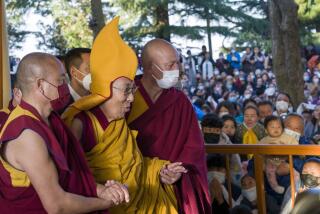White House Gives Dalai Lama the Rushdie Treatment
- Share via
WASHINGTON — The Dalai Lama visited the White House on Thursday and got the Salman Rushdie treatment.
In a meeting carefully arranged to minimize offense to China, the peripatetic Tibetan leader was permitted 15 minutes with President Clinton.
The session was labeled “unofficial” and took place not in the Oval Office but down the hall in the West Wing suite of Vice President Al Gore. Clinton had displayed similar caution last November when he met with Rushdie, a British author condemned to death by Iran, which accuses him of blaspheming Islam in his writings.
A White House news release Thursday night avoided even saying directly that Clinton had met with the Dalai Lama. Instead, it said the Dalai Lama had met with Gore and the President “joined the meeting.”
The Dalai Lama’s low-key, late-afternoon White House reception followed formal protests of the meeting by the Chinese government, which branded the Dalai Lama “a political exile who has for a long time engaged in activities aimed at splitting the motherland.”
“It’s not official, in the sense that he (the Dalai Lama) is not a government leader,” explained one senior Clinton Administration official Thursday. “This is a President paying his respects to a notable religious leader.”
He volunteered the decades-old United States position that Tibet is part of China.
Despite the White House skittishness, the International Campaign for Tibet, an advocacy group, praised Clinton’s decision to meet with the Dalai Lama as “an important indication of the Administration’s continued support for Tibet and for negotiations between the Dalai Lama and Beijing.”
Gore had also met separately with the Tibetan leader. Tibetan officials hope the meeting will pave the way for leaders of other countries to meet with the Dalai Lama.
It was not the first face-to-face session the Dalai Lama has ever had with a U.S. President; he had a comparable “drop-by” meeting with Clinton in Gore’s office one year ago and met privately with President Bush in 1991.
But the session took on added importance because the Clinton Administration must decide by June 3 whether to renew China’s U.S. trade benefits. One marker the President set down for making that decision is whether Beijing has made progress in preserving Tibet’s religious heritage, of which the Dalai Lama is the leading symbol.
China’s Communist regime moved troops into Tibet in 1950, shortly after it had won China’s civil war. The Dalai Lama was forced to leave the Tibetan capital of Lhasa in 1959, after an unsuccessful Tibetan revolt, and has lived in exile since. Officials in Beijing have claimed that China has always had sovereignty over Tibet; Tibetans claim that their land was independent before the invasion of the People’s Liberation Army.
Last week, after Assistant Secretary of State for Human Rights John Shattuck announced that Clinton might meet with the Dalai Lama, China’s Foreign Ministry expressed “grave concern.”
A Chinese spokesman said such a meeting would be “an interference in China’s internal affairs.”
A senior Administration official said Thursday that the Administration never thought about canceling the meeting.
“There’s no way you can allow them (Chinese officials) to intimidate you for doing something you’ve done before, and that your predecessor did,” he said.
The statement released by the White House on Thursday night said Clinton had wanted “to pay his respects to the Dalai Lama, to discuss efforts to initiate a dialogue with the Chinese leadership and to inquire about efforts to preserve Tibetan religion and culture.”
Tibet has a number of prominent supporters on Capitol Hill, such as Sen. Daniel Patrick Moynihan (D-N.Y.) and California Rep. Tom Lantos (D-Burlingame), chairman of the House Foreign Affairs subcommittee on human rights.
More to Read
Sign up for Essential California
The most important California stories and recommendations in your inbox every morning.
You may occasionally receive promotional content from the Los Angeles Times.













